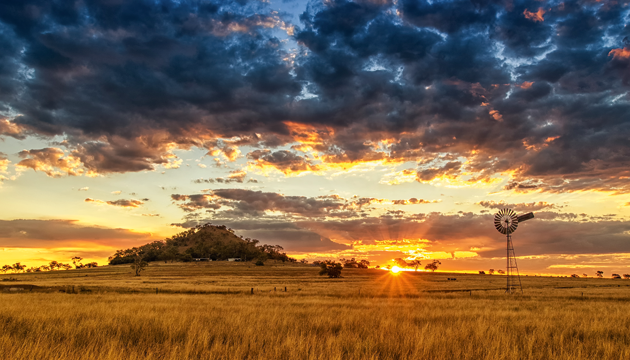One of Australia’s richest and most fertile food bowls and a growing hub for rural businesses, the Darling Downs is on the up and up.
Story Ken Eastwood Photo Cindi Iverson
Bounded by the magnificent Bunya Mountains in the north, the Great Dividing Range in the east, the state border in the south, and a ragged western border that falls between Miles and Roma, the Darling Downs has revered black soils that allow farmers the rare privilege of two crops a year. It’s a region of rich and prolific diversity, where almost everything seems to grow in abundance and intensive farming is increasingly king. “Eighty percent of Australia’s eggs come from here,” says Shane Charles, executive chairman of the Toowoomba and Surat Basin Enterprise. “We also have more feedlots per square kilometre than anywhere else in the country.” The Downs’ 255,000 people, spread across 77,000 square kilometres, have the lowest unemployment rates in Queensland (less than 4 percent). People across the country send their kids to the eight boarding schools here, including the largest primary boarding school in the country, or the tertiary education facilities at the University of Southern Queensland and TAFE Queensland South West. Graziers who have had it tough all their lives on less friendly country retire to the Downs, content to keep a few head and take life a little easier. Even in the furthest reaches of the Downs it’s only about an hour’s drive to a reasonable-sized town.
The Downs’ climate, historic sites, boutique industries and the fact it’s only a couple of hours’ drive from Brisbane, means it’s not only attractive to tourists, but also for a swag of new industries and opportunities. That’s probably best symbolised by the 75 commercial flights now flying into Wellcamp Airport in Toowoomba, Australia’s newest and first privately owned commercial airport, which is giving primary producers direct access to markets in Australia, Asia and the rest of the world. “The airport has been catalytic in the way we think about ourselves,” Shane says. “I cannot recall such a level of optimism and enthusiasm in my 40-odd years of living in the region. It’s a key piece in connectivity to the rest of Australia.”
Some $13 billion is being spent on development in the region at the moment – bypasses, hotels, gas exploration, renewable energy projects, giant shopping centres and industrial development around the new airport – but Shane says something else really defines the guts of the region. “Agriculture is in our DNA. It’s in our blood. Coal seam gas, professional services and education may go well, but it’s not until you get a good agricultural season that the place really starts to hum.”
This story excerpt is from Issue #113
Outback Magazine: June/July 2017










